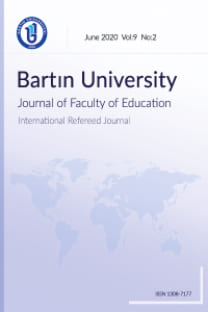Investigating the Validity and Reliability of the Mobile Application Rating Scale
Investigating the Validity and Reliability of the Mobile Application Rating Scale
Mobile learning system, mobile app rating, digital parenting scale adaptation, validity, reliability,
___
- Aloul, F., Zahidi, S., & El-Hajj, W. (2009). Multi factor authentication using mobile phones. International Journal of Mathematics and Computer Science, 4(2), 65-80.
- Bardus, M., Awada, N., Ghandour, L. A., Fares, E. J., Gherbal, T., Al-Zanati, T., & Stoyanov, S. R. (2020). The Arabic version of the Mobile App Rating Scale: development and validation study. JMIR mHealth and uHealth, 8(3), e16956.
- Çakır, H., & Arslan, İ. (2013). Mobil cihazlar için ders içerik paketinin geliştirilmesi [Development of course content package for mobile devices.]. Bilişim Teknolojileri Dergisi, 6(3), 24-33.
- Costa., P. D., (2003) Towards a Services Platform for Context-Aware Applications”, Yüksek Lisans Tezi, University of Twente Telematics, Enschede, The Netherlands, 10-35
- Epskamp, S. (2022). semPlot: Path Diagrams and Visual Analysis of Various SEM Packages' Output. R package version 1.1.5. https://CRAN.R-project.org/package=semPlot
- Fornell, C., & Larcker, D. F. (1981). Evaluating structural equation models with unobservable variables and measurement error. Journal of Marketing Research, 18(1), 39-50.
- Griggs, K., Bridges, L. M., & Rempel, H. G. (2009). Library/mobile: tips on designing and developing mobile web sites. Code4lib journal, (8).
- Harrell, F.E. (2021). Hmisc: Harrell Miscellaneous. R package version 4.6-0. https://CRAN.R-project.org/package=Hmisc
- Hee Ko, K. K., Kim, S. K., Lee, Y., Lee, J. Y., & Stoyanov, S. R. (2022). Validation of a Korean version of mobile app rating scale (MARS) for apps targeting disease management. Health Informatics Journal, 28(2), 14604582221091975.
- Korkmaz, S., & Arıkan, G. (2021). e-Nabız Uygulamasını Değerlendirmek İçin Kullanılan Yeni Bir Araç: Mobil Uygulama Derecelendirme Ölçeği[A New Tool Used to Evaluate e-Nabız Application: Mobile Application Rating Scale.]. Ankara Hacı Bayram Veli Üniversitesi İktisadi ve İdari Bilimler Fakültesi Dergisi, 23(3), 625-636.
- Mendi, O., Sari, M. K., Stoyanov, S., & Mendi, B. (2022). Development and validation of the Turkish version of the Mobile App Rating Scale–MARS-TR. International Journal of Medical Informatics, 166, 104843.
- Messner, E. M., Terhorst, Y., Barke, A., Baumeister, H., Stoyanov, S., Hides, L., ... & Probst, T. (2020). The German version of the Mobile App Rating Scale (MARS-G): development and validation study. JMIR mHealth and uHealth, 8(3), e14479.
- R Core Team. (2021). R: A language and environment for statistical computing. R Foundation for Statistical Computing, Vienna, Austria. URL https://www.R-project.org/.
- Robitzsch, A. (2021). sirt: Supplementary Item Response Theory Models. R package version 3.11-21. https://CRAN.R-project.org/package=sirt
- Rosseel, Y. (2012). lavaan: An R Package for Structural Equation Modeling. Journal of Statistical Software, 48(2), 1-36. https://doi.org/10.18637/jss.v048.i02
- Şimşek, M. V., Betin-Can, A., & Can, B. (2016). Android Uygulamalar İçin Yazılım Kalite Modeli [Software Quality Model for Android Applications].
- Stoyanov, S. R., Hides, L., Kavanagh, D. J., Zelenko, O., Tjondronegoro, D., & Mani, M. (2015). Mobile app rating scale: a new tool for assessing the quality of health mobile apps. JMIR mHealth and uHealth, 3(1), e3422.
- Subramanya, S. R., & Yi, B. K. (2006). User interfaces for mobile content. Computer, 39(4), 85-87.
- Terhorst, Y., Philippi, P., Sander, L. B., Schultchen, D., Paganini, S., Bardus, M., ... & Messner, E. M. (2020). Validation of the mobile application rating scale (MARS). Plos one, 15(11), e0241480.
- Tierney, N., Cook, D., McBain, M., & Fay, C. (2021). naniar: Data Structures, Summaries, and Visualisations for Missing Data. R package version 0.6.1. https://CRAN.R-project.org/package=naniar
- Van Buuren, S., & Groothuis-Oudshoorn, K. (2011). mice: Multivariate Imputation by Chained Equations in R. Journal of Statistical Software, 45(3), 1-67. DOI 10.18637/jss.v045.i03
- Yamamoto, K., Ito, M., Sakata, M., Koizumi, S., Hashisako, M., Sato, M., ... & Furukawa, T. A. (2022). Development and validation of a Japanese version of the Mobile App Rating Scale (MARS). JMIR Mhealth and Uhealth.
- Yayın Aralığı: 4
- Başlangıç: 2012
- Yayıncı: Bartın Üniversitesi Eğitim Fakültesi
Nilüfer KAHRAMAN, Esra SÖZER BOZ, Derya AKBAŞ, Ergün Cihat ÇORBACI, Şerife IŞIK, Nazife ÜZBE ATALAY, Fatma Nur AYDIN, Mehtap ÇAKAN, Şeref SAĞIROĞLU
TIMSS 2015 Fen Duyuşsal Özelliklerinin Cinsiyet ve Bölgelere Göre İncelenmesi
Mehmet Can DEMİR, Selahattin GELBAL
Eğitimde Sanal Gerçeklik (SG): Türkiye’deki Durum
Türkiye’de Ortaokul “Çevre Eğitimi ve İklim Değişikliği Dersi”nin Tarihsel Gelişim Süreci
Üniversite Öğrencileri arasında Kendini Yaralama Davranışının Yordayıcıları
Bilge SULAK AKYÜZ, Christine Suniti BHAT
A Study on Rubric Development to Evaluate Writing Skill in Teaching Turkish as a Foreign Language
